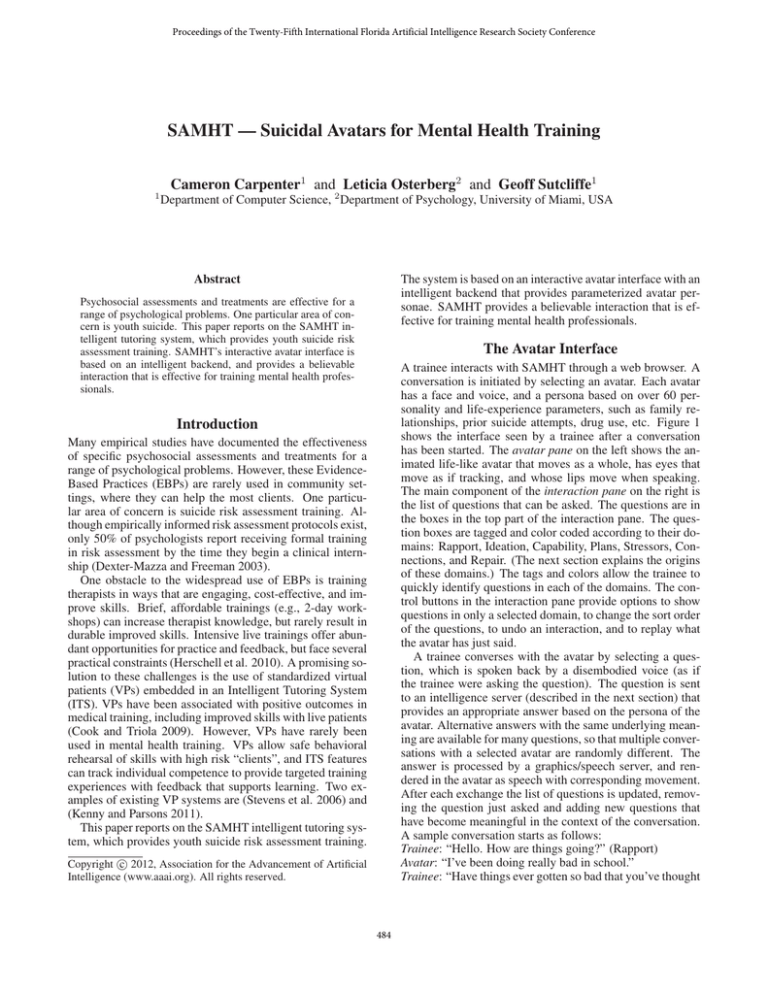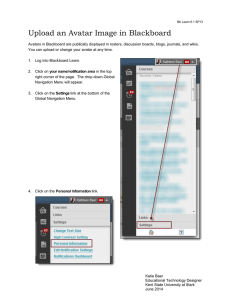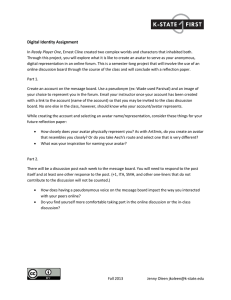
Proceedings of the Twenty-Fifth International Florida Artificial Intelligence Research Society Conference
SAMHT — Suicidal Avatars for Mental Health Training
Cameron Carpenter1 and Leticia Osterberg2 and Geoff Sutcliffe1
1
Department of Computer Science, 2 Department of Psychology, University of Miami, USA
Abstract
The system is based on an interactive avatar interface with an
intelligent backend that provides parameterized avatar personae. SAMHT provides a believable interaction that is effective for training mental health professionals.
Psychosocial assessments and treatments are effective for a
range of psychological problems. One particular area of concern is youth suicide. This paper reports on the SAMHT intelligent tutoring system, which provides youth suicide risk
assessment training. SAMHT’s interactive avatar interface is
based on an intelligent backend, and provides a believable
interaction that is effective for training mental health professionals.
The Avatar Interface
A trainee interacts with SAMHT through a web browser. A
conversation is initiated by selecting an avatar. Each avatar
has a face and voice, and a persona based on over 60 personality and life-experience parameters, such as family relationships, prior suicide attempts, drug use, etc. Figure 1
shows the interface seen by a trainee after a conversation
has been started. The avatar pane on the left shows the animated life-like avatar that moves as a whole, has eyes that
move as if tracking, and whose lips move when speaking.
The main component of the interaction pane on the right is
the list of questions that can be asked. The questions are in
the boxes in the top part of the interaction pane. The question boxes are tagged and color coded according to their domains: Rapport, Ideation, Capability, Plans, Stressors, Connections, and Repair. (The next section explains the origins
of these domains.) The tags and colors allow the trainee to
quickly identify questions in each of the domains. The control buttons in the interaction pane provide options to show
questions in only a selected domain, to change the sort order
of the questions, to undo an interaction, and to replay what
the avatar has just said.
A trainee converses with the avatar by selecting a question, which is spoken back by a disembodied voice (as if
the trainee were asking the question). The question is sent
to an intelligence server (described in the next section) that
provides an appropriate answer based on the persona of the
avatar. Alternative answers with the same underlying meaning are available for many questions, so that multiple conversations with a selected avatar are randomly different. The
answer is processed by a graphics/speech server, and rendered in the avatar as speech with corresponding movement.
After each exchange the list of questions is updated, removing the question just asked and adding new questions that
have become meaningful in the context of the conversation.
A sample conversation starts as follows:
Trainee: “Hello. How are things going?” (Rapport)
Avatar: “I’ve been doing really bad in school.”
Trainee: “Have things ever gotten so bad that you’ve thought
Introduction
Many empirical studies have documented the effectiveness
of specific psychosocial assessments and treatments for a
range of psychological problems. However, these EvidenceBased Practices (EBPs) are rarely used in community settings, where they can help the most clients. One particular area of concern is suicide risk assessment training. Although empirically informed risk assessment protocols exist,
only 50% of psychologists report receiving formal training
in risk assessment by the time they begin a clinical internship (Dexter-Mazza and Freeman 2003).
One obstacle to the widespread use of EBPs is training
therapists in ways that are engaging, cost-effective, and improve skills. Brief, affordable trainings (e.g., 2-day workshops) can increase therapist knowledge, but rarely result in
durable improved skills. Intensive live trainings offer abundant opportunities for practice and feedback, but face several
practical constraints (Herschell et al. 2010). A promising solution to these challenges is the use of standardized virtual
patients (VPs) embedded in an Intelligent Tutoring System
(ITS). VPs have been associated with positive outcomes in
medical training, including improved skills with live patients
(Cook and Triola 2009). However, VPs have rarely been
used in mental health training. VPs allow safe behavioral
rehearsal of skills with high risk “clients”, and ITS features
can track individual competence to provide targeted training
experiences with feedback that supports learning. Two examples of existing VP systems are (Stevens et al. 2006) and
(Kenny and Parsons 2011).
This paper reports on the SAMHT intelligent tutoring system, which provides youth suicide risk assessment training.
c 2012, Association for the Advancement of Artificial
Copyright Intelligence (www.aaai.org). All rights reserved.
484
Figure 1: Avatar Interface
about killing yourself?” (Ideation)
Avatar: “Yeah, I’ve been thinking about it lately.”
At this point a new question becomes available, and the
trainee chooses to ask it next. Note that this question would
not have made sense before the previous answer, and is thus
made available only in this new context.
Trainee: “How often do you think about it?” (Ideation)
Avatar: “Oh, probably like once a week.”
Trainee: “Have you ever tried to kill yourself?” (Capability)
Avatar: “Well, I’ve thought about it.”
etc. etc. When the trainee believes (s)he has enough information to make a risk assessment, the conversation is ended
by selecting the level of risk from a pulldown menu, one of
None, Mild, Moderate, High, or Extreme.
interface provides a panel that allows the trainee to add arbitrary notes to the conversation log. This feature is initially
aimed at obtaining suggestions and debugging information
from trainees during their use of the system, but in the long
term will be useful for trainees to make clinical notes during
their conversation with the avatar.
Intelligence Architecture
Figure 2 shows the SAMHT system architecture. The heart
of the avatars’ intelligence is the decision tree, which provides the answers for the questions sent from the trainee’s
web browser interface. Figure 3 shows an excerpt from a
graphical rendering of the decision tree. The decision tree is
an irreflexive directed tree with four types of nodes: question
nodes (rectangles in Figure 3), decision nodes (ovals), randomizer nodes (diamonds), and answer nodes (hexagons).
Each question node has one outgoing edge, leading to either
a decision node or a randomizer node. Each decision node
is labelled with one of the persona parameters (recall, there
are more than 60 parameters), and has one or more outgo-
In order to support assessment of trainees’ activities, all
interactions in a conversation are logged with a time stamp.
In future work this data will be mined to evaluate the system
and the trainees, and will also be used to provide real-time
feedback to trainees.
In addition to the avatar and interaction panes, the trainee
485
Preparations, Stressors and Perceived Burden, and Caring
Connections. Questions within each domain were created by
consulting literature on suicide risk assessment, and in consultation with child clinical psychologists and experts in suicide risk assessment. In addition to these risk assessment domains, the Rapport and Repair domains were created, again
in consultation with child clinical psychologists. Rapport
contains questions and statements used to open a conversation. Repair contains questions and statements used to address a client’s negative reactions during a conversation, and
thus “repair” any threats to the therapeutic relationship and
productiveness of the session. The decision tree has been
reviewed by clinical psychologists and psychology graduate students, who provided feedback on the structure, ageappropriateness, context-appropriateness, and believability
of the content.
The SitePal1 component of the architecture provides the
moving avatar image and speech rendering in Flash format,
based on the answer provided by the decision tree. The interaction with SitePal goes via the trainees’ web browser,
which receives the answer as text from the intelligence
server, forwards it to SitePal, and directly receives the rendering in the image view of the interface.
Figure 2: Intelligence Architecture
ing edges, each leading to another decision node, a randomizer node, or an answer node. These edges are labelled by a
value or value range of the decision node’s parameter. The
parameter values can be null, boolean, integer, real, string,
enumerated, or an array (of boolean, integer, real, string, or
enumerated) values. Each randomizer node has one or more
outgoing edges, each leading to a decision node or an answer
node. Each answer node contains an answer to a question.
When a question is delivered to the intelligence server
a traversal of the decision tree starts at the corresponding
question node, following the outgoing edge (the solid edges
in Figure 3). Whenever a decision node is encountered the
avatar’s parameter value determines which outgoing edge is
followed. Whenever a randomizer node is encountered an
outgoing edge is chosen randomly. Randomizer nodes are
used to randomly select an answer from several that have
the same underlying meaning, or to direct the traversal to
another decision node. When an answer node is reached it
is returned as the answer to the originating question. Aligning Figure 3 with the conversation extract above, when the
question “Have things ever gotten so bad that you’ve thought
about killing yourself?” was asked, the avatar parameter
LIFEIDEA had the value current, leading to the answer
returned. If the value had been past-and-current then
randomly one of the answers below the randomizer node
would have been returned.
In addition to the tree edges, there is a separate layer of
edges leading from answers to questions (the dashed edges
in Figure 3). When an answer has been reached, these edges
lead to questions that have become meaningful in the context of the conversation, and they are added to the list of
questions in the interaction pane of the web browser interface. For the conversation extract above, in Figure 3 this is
the dashed edge to the question “How often do you think
about it?”.
The decision tree was hand-crafted by the second author, who has direct experience working with children and
adolescents in clinical settings. A well established framework for suicide risk assessment (Joiner et al. 1999;
2009) was used as a guide for which topics to cover, and for
how to integrate the information obtained from the avatar to
determine the level of risk. The framework organizes the
content of a thorough risk assessment interview into five domains: Desire and Ideation, Acquired Capability, Plans and
Conclusion
This paper has described SAMHT, an intelligent tutoring
system for youth suicide risk assessment training. Its interactive avatar interface is based on an intelligent backend that
provides a believable interaction that is effective for training
mental health professionals.
Immediate future work is to provide trainees with realtime performance feedback, by analyzing the conversation
logs. New interface elements that indicate the trainee’s
progress in the conversation are being planned, e.g., time
spent in the interview, the percentage of questions covered
from each domain, the level of rapport achieved, and the
amount of useful information obtained from the conversation. More directed feedback to trainees might also be automated, e.g., indications of whether a selected question is
(in)appropriate. An ability to compute each avatar’s level
of risk, based on risk assessment literature, e.g., (Joiner et
al. 1999), will be added. This will allow trainees to receive
feedback about the accuracy of their assessment at the end
of each conversation. The feedback features will enable the
trainer to scaffold learning for novice trainees. A medium
term goal is to automate the process of creating new avatar
personae, by randomly selecting parameter values subject to
constraints that avoid combinations that are illogical, unrealistic, etc. In the longer term the conversation logs will be
used to guide the selection of parameters values, so that new
avatars help trainees focus on weaknesses in prior conversations. Additional planned features include functionality to
encourage rehearsal of behaviors that should happen in a live
risk assessment. Examples include adding a medical chart
containing patient history data to encourage trainees to consult charts prior to interviewing patients, and adding voice
1
486
http://www.sitepal.com
Figure 3: A Decision Tree
recognition and question matching capability so trainees can
behaviorally rehearse asking questions.
Outpatient Practice. Professional Psychology: Research and
Practice 30(5):447–453.
Joiner, T.; van Orden, K.; Witte, T.; and Rudd, M. 2009.
Risk Assessment. In Joiner, T.; van Orden, K.; Witte, T.;
Rudd, M.; and David, M., eds., The Interpersonal Theory of
Suicide: Guidance for Working With Suicidal Clients. American Psychological Association. 53–81.
Kenny, P., and Parsons, T. 2011. Embodied Conversational
Virtual Patients. In Perez-Marin, D., and Pascual-Nieto, I.,
eds., Conversational Agents and Natural Language Interaction: Techniques and Effective Practices. Information Science Reference. 254–281.
Stevens, A.; Hernandez, J.; Johnsen, K.; Dickerson, R.; Raij,
A.; Harrison, C.; DiPietro, M.; Allen, B.; Ferdig, R.; Foti,
S.; Jackson, J.; Shin, M.; Cendan, J.; Watson, R.; Duerson,
M.; Lok, B.; Cohen, M.; Wagner, P.; and Lind, D. 2006.
The Use of Virtual Patients to Teach Medical Students History Taking and Communication Skills. American Journal
of Surgery 191(6):806–811.
Acknowledgements This project is supported by a
grant from the National Institute of Mental Health
(R36 MH095417-0), from the National Institutes of Health.
References
Cook, D., and Triola, M. 2009. Virtual Patients: A Critical Literature Review and Proposed Next Steps. Medical
Education 43(4):303–311.
Dexter-Mazza, E., and Freeman, K. 2003. Graduate
Training and the Treatment of Suicidal Clients: The Students’ Perspective. Suicide and Life-Threatening Behavior
33(2):211–218.
Herschell, A.; Kolko, D.; Baumann, B.; and Davis, A. 2010.
The Role of Therapist Training in the Implementation of
Psychosocial Treatments: A Review and Critique with Recommendations. Clinical Psychology Review 30(4):448–466.
Joiner, T.; Walker, R.; Rudd, M.; and Jobes, D. 1999. Scientizing and Routinizing the Assessment of Suicidality in
487






